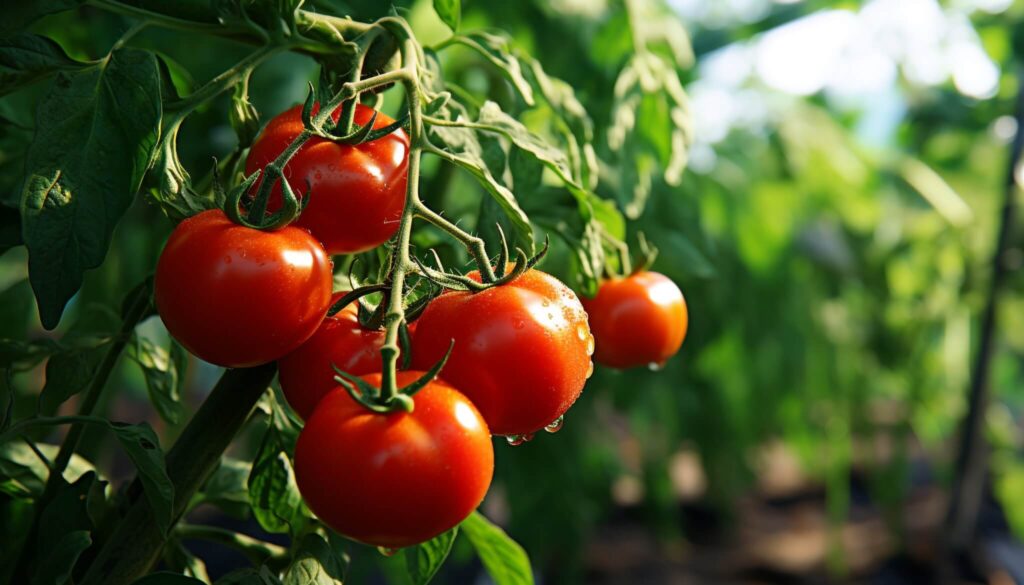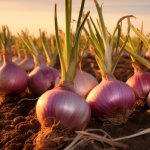The tomato (Solanum lycopersicum) is one of the most widespread vegetables in the world and the prospects for the evolution of the crop are great, due to its market potential both in its natural form and in its industrialized form (FERREIRA et al., 2010).
Tomato plants are one of the most demanding vegetables in terms of fertilization (DE OLIVEIRA et al., 2023). At the beginning of its cycle, the crop presents low nutrient absorption, but tomato planting requires a large amount of nutrients in other stages of development, mainly at the beginning of flowering and fruit growth (DIAS, 2020). According to Pereira (2018), the estimated use of fertilizers in tomato crops is 1,875 kg ha-1.
Proper plant nutrition directly reflects on the final product and its post-harvest durability. To this end, the input market has been modernizing and seeking products that meet the needs of producers in the cultivation of this vegetable (DE OLIVEIRA et al., 2023).
NPK fertilization is important for tomato plants because it is linked to the disposition of assimilates, helping in the growth and development of the crop (DA SILVA et al., 2018). Nitrogen increases production, as it influences vegetative growth and the photosynthetic aerial part, but it must be applied in the recommended amount, as excess can cause problems such as hollow fruits and make them more susceptible to phytosanitary problems (FILGUEIRA, 2008).
Potassium interferes with fruit quality, as it is associated with the process of synthesis and translocation of carbohydrates that occur in the fruit (PIMENTEL, 2004). Phosphorus is a limiting macronutrient, among its essential functions it is related to the structural aspect, photosynthesis and respiration, influencing better root growth, seed formation and improvement in fruit characteristics (PRADO, 2008; MUELLER, 2018).
Calcium and boron are nutrients that are linked to physiological disorders in tomatoes, apical rot and open locule, respectively, and according to Hahn et al. (2017), they affect fruit production and quality, as they act on the cellular structure and the activation of vital reactions in the plant, having similar functions in relation to cell division and elongation and in the formation of the cell wall (ALVES, 2021).
Calcium is essential for good plant growth and productivity. The nutrient is essential for maintaining good fruit structure and quality. The importance of calcium at different stages of tomato growth is highlighted in flowering and fruiting, as it increases the reproductive development of plants. During fruit ripening, it maintains fruit firmness and quality, reducing the risk of blossom-end rot (Figure 1).

Figure 1- Symptoms of calcium deficiency in tomatoes. Source: Agrologica.
Regarding fertilization, highly soluble chemical fertilizers are used, which are organic matter degrading agents (LUZ et al., 2007). In this sense, a good alternative in fertilization are organominerals that provide sustainable soil management, promoting sustainability in the short, medium and long term and preservation of natural resources (MOTA et al., 2019; CHÁVEZ et al., 2019).
THE organomineral It is a fertilizer that results from the physical mixture or combination of mineral and organic fertilizers. Unlike mineral fertilizers, organomineral fertilizers provide nutrients slowly, so that the crop can absorb the essential nutrients during each phase of its cycle (DE OLIVEIRA et al., 2023).
Studies with different vegetable crops and comparing organomineral and mineral fertilization observed that organomineral fertilizers were efficient in increasing shelf life for beets (FERNANDES et al., 2020), strawberries (FARNEZI et al., 2020) and lettuce (AGUIAR et al., 2021), as well as providing greater gains in productivity for such crops.
A worrying factor is that tomato production in many areas of Brazil has often been limited due to excess dissolved salts in the soil solution (MEDEIROS et al., 2012). Salinity has been a factor responsible for one of the abiotic stresses that most limits plant growth and tomato productivity, especially in protected cultivation areas (GUEDES et al., 2015). Excess salts in the soil in protected crops are quite common due, in most cases, to high doses of fertilizers applied and the lack of leaching of accumulated salts after a crop. The continuous use of mineral fertilizers has resulted in problems in terms of soil degradation, which causes a rapid reduction in the organic matter content, salinization, and resulting in the impoverishment of nutrients in this soil (SILVA et al., 2007). Part of the fertilizer added to the soil is consumed and the remainder is deposited in the soil colloids, capable of increasing concentration, especially after successive applications, and may reach the point of reducing vegetative development and crop yield (DE OLIVEIRA et al., 2023).
Organomineral fertilizers have been used to mitigate saline stress (SOUZA et al., 2018). Studies have shown that the application of organominerals has a lower environmental impact compared to conventional mineral fertilizers. The advantages include reduced soil salinity and reduced nutrient leaching (LANA et al., 2020).
Organomineral fertilizers offer several attributes that promote gains in crop production due to the action of organic matter, favoring better use of mineral nutrients (DE OLIVEIRA et al., 2023).
The organic matter present in organomineral fertilizers, together with mineral nutrients, facilitates their absorption and helps in the transport of photoassimilates produced by the plant itself (ALMEIDA et al., 2019). In organominerals, the slow release of nutrients occurs, tending to persist for a longer period in the soil (AGUILAR et al., 2019; SOUZA et al., 2020).
In the study developed by Luz et al. (2010) evaluating the productivity of 'Débora Pto' tomatoes with the application of organomineral fertilizer, the researchers were able to observe that in the first two weeks of harvest there was no difference between the treatments tested. However, from the third week onwards there was an increase in the average marketable tomato, showing greater production. The evaluation of different sources in the supply of nutrients under equal soil and climate conditions allows visualizing the greater productive potential of the crop and quality of the fruits with organomineral fertilizers.
Organomineral nutrition allows tomato plants to make better use of essential nutrients, more efficiently, during each phase of their production cycle, favoring crop growth, productivity and post-harvest quality. The application of organomineral fertilization meets the nutritional requirements of the crop and provides its growth in a healthy way, in addition to increasing its productivity (DE OLIVEIRA et al., 2023).
Organomineral fertilizer, as a top dressing, provides an increase in the number of marketable fruits per plant, average fruit weight, fresh mass, dry mass of fruits per plant, diameter and average crop productivity. These results support that organomineral top dressing fertilization in industrial tomato plants favors attributes that can increase productivity and reduce the use of mineral nutrients (PERES; TERRA; REZENDE, 2020).
In view of this, ILSA can contribute with GRADUAL MIX in the NPK formulation which, according to the soil analysis, will provide the best formulation, contributing efficiently since ILSA products can gradually provide nutrients to the plants.
N-TIME is rich in nitrogen and carbon. In vegetables, it can be used as a substitute for manure. It should be applied when preparing the soil (10-15 days before planting).
As a complement to soil fertilization, a good option during the flowering and fruit formation period is ILSAMIN CAMG. This is a liquid organomineral fertilizer based on enzymatically hydrolyzed proteins (GELAMIN), which represents a natural source of rapidly absorbed amino acids, making nitrogen, calcium and magnesium available to plants, also helping them to face periods of biotic and abiotic adversity.
References:
AGUILAR, Ariel Santivañez et al. Influence of organomineral fertilization in the development of the potato crop cv. Cupid. 2019.
DE AGUIAR, Fabrício Resende et al. Production and quality of beets subjected to different fertilization management and residual effect on the production of corn grown in succession. Journal of Environmental Analysis and Progress, v. 6, no. 1, p. 060-070, 2021.
ALMEIDA, Marcelo José de et al. Deficient water replacement and organomineral fertilization on the growth and production of industrial tomato plants. 2017.
ALVES, Bárbara da Silva. Vegetative performance of tomato crops under different fertilization rates. Final course work. UNIVERSITY OF BRASILIA. 2021.
CHÁVEZ, Pavel Chaveli et al. Organomineral fertilization in sustainable management of lands cultivated with corn (Zea mays L.). Agroecosistemas Scientific Magazine, v. 7, no. 3, p. 116-122, 2019.
DA SILVA, VL et al. NPK doses in tomato cv. Marmande and its field performance in the Cerrado. JOURNAL OF NEOTROPICAL AGRICULTURE, v. 5, n. 1, p. 54-59, 2018.
DIAS, Guilherme et al. Fertilizer doses for tomato seedling production (Solanum Lycopersicum). Proceedings of the International Exhibition of Teaching, Research and Extension, v. 11, p. 14, 2020.
DE OLIVEIRA, Letícia Lopes et al. Response of cherry tomatoes to organomineral fertilization to increase productivity. Journal of Environmental Analysis and Progress, v. 8, no. 2, p. 054-061, 2023.
FARNEZI, Priscila Kelly Barroso et al. Production and physicochemical characterization of strawberry (Fragaria X Ananassa Duch) under different sources of phosphate fertilization. Brazilian Journal of Development, v. 6, no. 9, p. 65051-65066, 2020.
FERNANDES, Pedro Henrique et al. Use of organomineral phosphate fertilizers in the cultivation of lettuce and corn in succession. Brazilian Journal of Development, v. 6, no. 6, p. 37907-37922, 2020.
FERREIRA, Sila Mary Rodrigues et al. Post-harvest quality of conventional and organic table tomatoes. Food Science and Technology, v. 30, p. 858-869, 2010.
FILGUEIRA, FAR New manual of horticulture: Modern agrotechnology in the production and commercialization of vegetables. 3rd ed. Viçosa: UFV, 2008. 421p.
GUEDES, Rodolfo AA et al. Irrigation strategies with saline water in cherry tomatoes in a protected environment. Brazilian Journal of Agricultural and Environmental Engineering, v. 19, no. 10, p. 913-919, 2015.
HAHN, L. et al. Application of calcium and boron formulations in the cultivation of trellised tomato plants. Agropecuária Catarinense, v. 30, p. 61-66, 2017.
Lana, RMQ; Franco, MHR; Magela, MLM; Gontijo, LN Potential of organomineral fertilizers. Field and business magazine. 2020.
LUZ, José Magno Queiroz; SHINZATO, André Vinícius; SILVA, Monalisa Alves Diniz da. Comparison of conventional and organic tomato production systems in protected cultivation. Biosci. j.(Online), 2007.
MEDEIROS, Pedro RF et al. Tolerance of tomato crops to soil salinity in a protected environment. Brazilian Journal of Agricultural and Environmental Engineering, v. 16, p. 51-55, 2012.
MOTA, Raquel Pinheiro et al. Biosolid and sugarcane filter cake in the composition of organomineral fertilizer on soybean responses. International Journal of Recycling of Organic Waste in Agriculture, v. 8, p. 131-137, 2019.
MUELLER, S. et al. Splitting of phosphate fertilization in tomato planting and topdressing. Agropecuária Catarinense, v. 31, n. 2, p. 52-57, 2018.
Pereira, RB; Melo, RAC; Morais, AA Tomato late blight. Our Garlic, 28, 52-56. 2018.
PERES, Liliane Aparecida Cardoso; TERRA, Nathanael Fidelis; REZENDE, Claudia Fabiana Alves. Productivity of industrial tomato subjected to organomineral topdressing fertilization. Brazilian Journal of Development, v. 6, no. 3, p. 10586-10599, 2020.
PIMENTEL, C. The relationship between plants and water. Seropédica: Edur, 2004. 191p.
PRADO, R. M. Plant nutrition. São Paulo: Unesp, 2008. 407p.
Silva, TO; Menezes, RSC Organic fertilization of potatoes with manure and/or Crotalaria juncea. Availability of N, P and K in the soil throughout the crop cycle. Brazilian Journal of Soil Science,31, 51-61. 2007.
SOUZA, José TA et al. Effects of water salinity and organomineral fertilization on leaf composition and production in Passiflora edulis. Brazilian Journal of Agricultural and Environmental Engineering, v. 22, p. 535-540, 2018.
SOUZA, Marliezer Tavares et al. Plant height and stem diameter in second-cut sugarcane fertilized with organomineral from sewage sludge and biostimulant. Brazilian Journal of Development, v. 6, no. 1, p. 1988-1994, 2020.
Authors:
Agr Eng. Dr. Angélica Schmitz Heinzen
Agricultural Eng. Msc. Thiago Stella de Freitas
Agricultural Engineer Tuíra Barcellos






